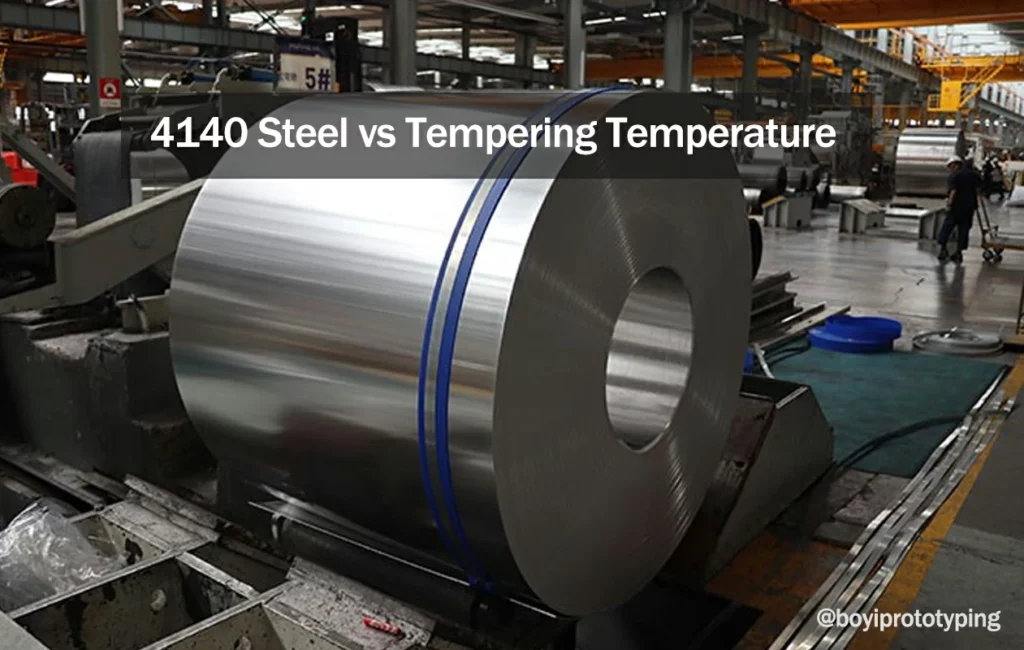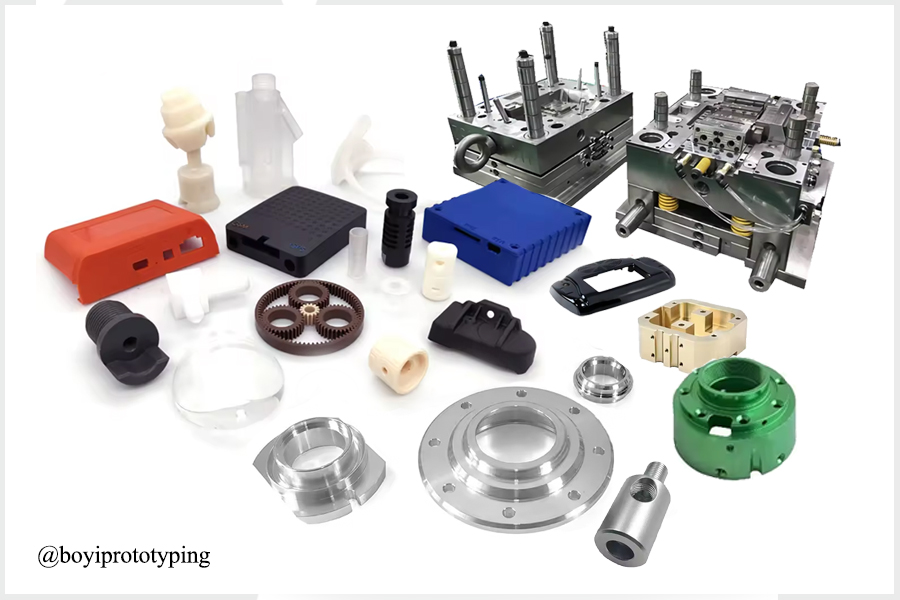
4140 steel is a chromium-molybdenum alloy known for its toughness, good fatigue strength, and resistance to wear and abrasion. It’s widely used in the manufacturing of parts like gears, bolts, and shafts—components that need to withstand significant stress. But to maximize these properties, the steel must be properly heat-treated, and tempering is a key step in this process.
4140 Steel Composition and Heat Treatment
4140 steel is an alloy steel that contains approximately 0.38-0.43% carbon, 0.75-1.00% manganese, 0.15-0.25% silicon, 0.80-1.10% chromium, and 0.15-0.25% molybdenum, with trace amounts of sulfur and phosphorus.
The heat treatment process typically involves three stages: austenitizing (heating to a high temperature and holding it to transform the steel’s microstructure into austenite), quenching (rapid cooling, usually in oil or water, to form martensite), and tempering (reheating the steel to a lower temperature to adjust its mechanical properties).
What is the Tempering Temperature for 4140 Steel?
4140 steel is typically tempered within a range of 400°F to 1300°F (200°C to 700°C). The tempering temperature chosen affects the steel’s hardness and toughness. Please refer to the following table for details.
| Process | Temperature Range | Holding Time | Cooling Method | Hardness (Brinell/Rockwell) | Tensile Strength (ksi) | Notes |
|---|---|---|---|---|---|---|
| Annealing | 1450 – 1600°F (790 – 870°C) | 1 hour (longer for thickness >1 inch) | Cool inside furnace | 197 Brinell (BHN) | – | Softens steel for easier machining |
| Normalizing | 1600 – 1700°F (870 – 925°C) | At least 30 minutes | Cool in ambient air | 241 Brinell (BHN) | 100 ksi | Improves mechanical properties |
| Hardening & Quenching | 1550 – 1600°F (845 – 870°C) | 30 minutes per inch of thickness | Quench in mineral oil | 600 Brinell (BHN) / Rockwell C 55 | 225 ksi | Quench immediately; cool to 150°F (65°C) before tempering |
| Tempering | 400 – 1300°F (200 – 700°C) | 15 minutes per inch of thickness | Air cool | 250 – 600 Brinell (BHN) / Rockwell C 25-50 | 130 – 225 ksi | Lower temperatures increase tensile strength; higher temperatures improve toughness |
Can 4140 Steel Be Flame Hardened?
Yes, 4140 steel can be flame hardened. Flame hardening is a surface hardening process commonly used on medium carbon steels like 4140. The process involves rapidly heating the surface of the steel with a flame followed by immediate quenching, which increases the surface hardness while maintaining a tough and ductile core.
What is the Stress Relieving Temperature for 4140 Steel?
The stress relieving temperature for 4140 steel typically ranges between 1100°F and 1300°F (593°C to 705°C). At this temperature, the steel is heated to reduce internal stresses introduced during machining, welding, or other processes without significantly altering its mechanical properties.
What is the Rockwell Hardness of 4140 Steel?
The Rockwell hardness of 4140 steel typically falls within the range of 28 to 32 HRC after being properly heat-treated.
What Temperature Should I Preheat 4140 Steel?
You should preheat 4140 steel to a temperature range of 350°F to 400°F (177°C to 204°C) before welding or machining. Preheating helps reduce the risk of cracking by minimizing thermal shock and ensuring a more uniform temperature distribution throughout the material.

What are the Advantage of 4140 Steel?
- Offers excellent tensile strength, making it suitable for demanding applications.
- Provides a good balance of toughness and strength, reducing the risk of brittle failure.
- Resistant to abrasion and wear, making it ideal for parts subjected to friction and impact.
- Used in a wide range of applications, including automotive, machinery, and tooling, due to its adaptability.
- Can be heat-treated to achieve a range of mechanical properties, including high hardness and strength.
- Performs well under impact and shock loads, making it reliable for heavy-duty applications.
What are the Disadvantages of 4140 Steel?
While 4140 steel is highly versatile and offers numerous advantages, it also has some disadvantages:
- Higher than carbon steels due to alloying elements and processing.
- Can be difficult to machine, leading to higher tool wear.
- Requires careful preheating and post-weld treatment to prevent cracking.
- Becomes brittle when hardened, needing proper tempering to avoid cracking.
- Susceptible to rust and corrosion without proper coating.
- Requires precise control during heat treatment to ensure consistent properties.
Difference Between 4140 Annealed and Pre-Hard Steel
| Property | 4140 Annealed Steel | 4140 Pre-Hard Steel |
|---|---|---|
| Heat Treatment | Heated and slowly cooled to relieve stress | Heat-treated to specific hardness before supply |
| Rockwell Hardness | Typically 14-22 HRC | Typically 28-32 HRC |
| Properties | Softer, more ductile, better machinability | Harder, less ductile, improved wear resistance |
| Applications | Ideal for machining and forming, further heat treatment possible | Suitable for applications requiring high strength and hardness, minimal further treatment |
| Further Treatment | Can be heat-treated later for higher hardness | Generally not heat-treated further |
Does 4140 Make a Good Knife?
4140 steel can make a functional knife, especially if toughness and durability are prioritized over edge sharpness and corrosion resistance. For high-performance knives, especially those requiring excellent edge retention and corrosion resistance, other steels like 440C, S30V, or CPM-3V might be preferred.
Is 4140 Harder Than Mild Steel?
4140 steel is harder and stronger than mild steel, particularly when heat-treated. This makes 4140 a better choice for applications requiring higher strength, durability, and wear resistance. Mild steel, being softer, is more suitable for applications where ease of machining and welding are more critical than high strength.
Conclusion
The tempering temperature of 4140 steel significantly influences its mechanical properties, allowing engineers to tailor the material’s performance to meet the demands of various industrial applications. By carefully selecting the tempering temperature, one can achieve the desired balance of hardness, strength, and toughness, ensuring the steel’s reliability and longevity in service.
BOYI using advanced precision CNC machining processes, we create components that are durable, reliable, and built to perform. Partner with us for high-quality production and outstanding service!

Let’s Start A New Project Today
Our engineers will contact you within 2 hours.
FAQ
The best tempering temperature for 4140 steel depends on the desired balance between hardness and toughness, typically ranging between 300°C to 450°C.
Tempering reduces the hardness of 4140 steel, with lower temperatures maintaining higher hardness and higher temperatures reducing hardness while increasing toughness.
Yes, 4140 steel can be tempered multiple times to fine-tune its mechanical properties. However, repeated tempering should be carefully controlled to avoid excessive softening.
Tempered 4140 steel is used in applications like gears, crankshafts, tools, and heavy machinery components, depending on the tempering temperature and the required mechanical properties.
If tempering is not done correctly, especially after improper quenching, there is a risk of cracking. Slow and controlled heating and cooling during tempering minimize this risk.
Quenching forms martensite in 4140 steel, which is hard and brittle. Tempering is then used to adjust this hardness and improve toughness by partially transforming martensite into other microstructures.
Tempering involves reheating quenched steel to reduce brittleness and increase toughness, while annealing involves heating the steel to a high temperature and slowly cooling it to soften the material and improve machinability.
To temper 4140 steel, heat the steel to a specific temperature between 150°C to 650°C based on the desired properties, then cool it slowly to achieve the desired toughness and hardness.
Catalog: Materials Guide

This article was written by engineers from the BOYI team. Fuquan Chen is a professional engineer and technical expert with 20 years of experience in rapid prototyping, mold manufacturing, and plastic injection molding.







